

Tropical Fish Profiles, covering the care and upkeep of many aquarium tropical freshwater fish. Danio sp. ‘hikari’ – Hikari Danio. Etymology Danio: from Dhani, a Bengalese vernacular term for small, minnow-like cyprinids. Classification Order: Cypriniformes Family: Cyprinidae Distribution Collected from the Tanintharyi River drainage, a tributary of the Tenasserim River system in Tanintharyi (formerly Tenasserim) Division, southern Myanmar. Habitat No details are available but expect it to inhabit quieter, slower-moving sections of streams and minor rivers.
Maximum Standard Length 55 – 65 mm. Aquarium SizeTop ↑ An aquarium with base dimensions of 120 ∗ 30 cm or equivalent should be the smallest considered. Maintenance Looks particularly effective in a heavily-planted arrangement with a darker substrate, and may appear paler in sparsely-decorated set-ups. We suggest maintaining it in a well-planted aquarium or set-up designed to resemble a flowing river or stream, with a substrate of variably-sized rocks and gravel and some large water-worn boulders. Water Conditions Temperature: 18 – 26 °C pH: 6.5 – 7.5. Melanotaenia lacustris (Lake Kutubu Rainbowfish. Classification Melanotaeniidae Distribution Papua New Guinea, Southern Highlands Province.
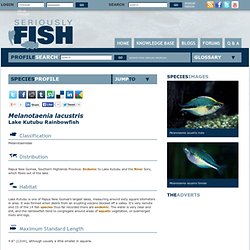
Endemic to Lake Kutubu and the River Soro, which flows out of the lake. Bedotia geayi, the Madagascan Rainbow Profile, with care, maintenance requirements and breeding information for your tropical fish. Overview: This Rainbow fish species is a very peaceful schooling fish.

Its’ unique shape and color makes it a very attractive fish for many! Iriatherina werneri – Threadfin Rainbowfish. Classification Order: Atheriniformes Family: Melanotaeniidae Distribution Described from ‘Merauke, Irian Jaya, Indonesia’ which corresponds to modern day Merauke Regency, Papua province, Indonesia, on the island of New Guinea.

It’s distributed along a relatively short section of New Guinea’s southern coast, between Merauke and the mouth of the Fly River across the border in Papua New Guinea, and in the latter watershed has been recorded over 500 km inland. Populations are also known from Lakes Bosset and Kala. In Australia records exist from numerous river basins of the Cape York Peninsula, Queensland state, plus the Northern Territory to the west, including the Arafura wetland in Arnhem Land.
Habitat. Bedotia madagascarensis (Madagascan Rainbow Fish. Classification Order: Atheriniformes Family: Bedotiidae Distribution Known only from small streams and the lower reaches of rivers, most of which drain into a series of coastal lagoons and lakes in Atsinanana region, eastern Madagascar. Although the extent of its historical range is unclear, modern distribution extends southwards from the lower Ivoloina River, just north of Toamasina city, as far as Manambalo Creek which lies south of the town of Vatomandry.
The lakes and rivers along this stretch of coastline are connected by the Canal des Pangalanes, an artificial waterway constructed to allow boat transport throughout the natural lake system. South of Manambalo Creek and in the middle and upper Ivoloina River this species is replaced by undescribed members of the genus, in middle and upper sections of rivers within the boundaries of its range by B. leucopteron, and north of the Ivoloina by B. longianalis. Habitat Maximum Standard Length 80 – 100 mm. Aquarium SizeTop ↑ Maintenance Diet. Black Ghost Knifefish, Apteronotus albifrons Species Profile, Black Ghost Knifefish Care Instructions, Black Ghost Knifefish Feeding and more.
Black Ghost Knifefish Aquarium Care, Feeding and Native Habitat Information The Black Ghost Knifefish (Apteronotus albifrons) is found widely distributed throughout the streams and rivers of the northern portion of South America.
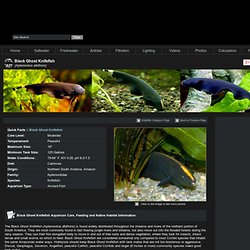
They are most commonly found in fast flowing jungle rivers and streams, but also move out into the flooded forests during the rainy season. They use their thin elongated body to move in and out of tree roots and dense vegetation, where they look for insects, insect larvae and small worms on which to feed. Black Ghost Knifefish are considered somewhat shy compared to most Cichlid species that inhabit the same Amazonian water ways.
Hobbyists should keep Black Ghost Knifefish with tank mates that are not too boisterous or aggressive. An ideal aquarium setup for keeping a Black Ghost Knife would be a 6 x 2 foot aquarium with sandy substrate, tree root, tall plants, moderate water flow and diffused lighting. Black Ghost Knife Fish, Apteronotus albifrons Profile, with care, maintenance requirements and breeding information for your tropical fish. Overview: One of the most stunning and odd looking fish we can keep.
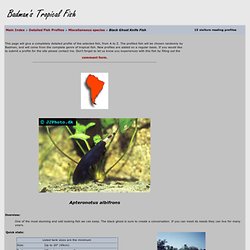
The black ghost is sure to create a conversation. If you can meet its needs they can live for many years. Black Ghost Knife - Apteronotus albifrons. Species name: Apteronotus albifrons Synonym: Apteronotus passan , Gymnotus albifrons, Sternarchus albifrons, Sternarchus lacepedii, Sternarchus maximilliani Common Names: Black Ghost Knife Family: Apteronotidae (Ghost knifefishes) Order: Gymnotiformes (knifefishes) Class: Actinopterygii (ray-finned fishes) Max. size: 50 cm / 20 inches.
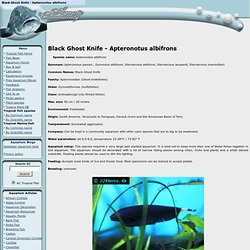
Siamese Fighting Fish - Betta Splendens. Scientific Name: Betta splendens Common Name: Betta, Siamese Fighting Fish Family: Belontiidae Origin: Cambodia, Thailand Adult Size: 3 inches (7 cm) Social: Males cannot be kept together Lifespan: 2-3 years Tank Level: Top dweller Minimum Tank Size: 2 gallon Diet: Live foods preferred, will eat flakes and frozen foods Breeding: Egglayer - bubblenest Care: Easy to Intermediate pH: 6.8 - 7.4 Hardness: up to 20 dGH Temperature: 75-86 F (24-30 C) Origin/Distribution Bettas originate in the shallow waters of Thailand (formerly called Siam, hence their name), Indonesia, Malaysia, Vietnam, and parts of China.

These areas are home to acres of rice paddies, ponds, slow moving streams and swamps, all of which are home to Bettas. Today Bettas have been introduced in many locations, giving rise to non-native populations in a number of countries. As demand has grown for Bettas, they have been captive-bred globally, both commercially and by private individuals. Description Tankmates Habitat/Care Diet. Google. Banded Gourami Care And Profile - Colisa Fasciata. Food and feeding Quality flake should be the staple diet of these fish.

The addition of spirulina flake will be of great benefit, as will treats of blood worms, tubifex, and brine shrimp. Origin South Asia; Banded gouramis are to be found in India, Bengal, and Burma. Sexing Males will display a more intense coloration and will have an extended dorsal fin. The dorsal fin in the females will be more rounded. Breeding The water level in the breeding tank should be dropped to a depth of about 8 inches. Lifespan The expected life span for Banded gourami is 4 years. Short description Colisa fasciata are sold in markets of India and Pakistan as snacks. Pictures Bought by aqua-fish.net from jjphoto.dk. Lemon tetra. The lemon tetra, Hyphessobrycon pulchripinnis, is a species of tropical freshwater fish which originates from South America, belonging to the family Characidae.
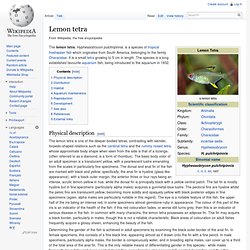
It is a small tetra growing to 5 cm in length. The species is a long established favourite aquarium fish, being introduced to the aquarium in 1932. Physical description[edit] The lemon tetra is one of the deeper-bodied tetras, contrasting with slender, torpedo-shaped relations such as the cardinal tetra and the rummy nosed tetra, whose approximate body shape when seen from the side is that of a lozenge,(often referred to as a diamond, is a form of rhombus).
The basic body color of an adult specimen is a translucent yellow, with a pearlescent lustre emanating from the scales in particularly fine specimens. Determining the gender of the fish is achieved in adult specimens by examining the black outer border of the anal fin. Juvenile fishes are usually translucent with only a hint of the colour of the adult. Distribution[edit] Lemon Tetra Hyphessobrycon pulchripinnis aquarium tropical fish from Tropical Fish and Aquariums. The Lemon Tetra originally came from the lower Amazon.
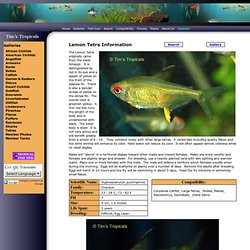
It is distinguished by red in its eye and a splash of yellow on the front of the adipose fin. There is also a slender streak of yellow on the dorsal fin. The overall color is greenish yellow. A thin red line runs the length of the body and is underscored with black. The lower body is silver. Males will "dance" in a territorial display toward other males and toward females.